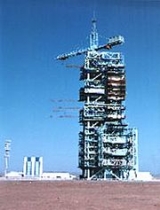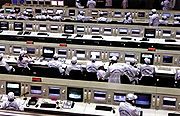
Jiuquan Satellite Launch Center
Encyclopedia

.png)
People's Republic of China
China , officially the People's Republic of China , is the most populous country in the world, with over 1.3 billion citizens. Located in East Asia, the country covers approximately 9.6 million square kilometres...
space vehicle launch facility (spaceport
Spaceport
A spaceport or cosmodrome is a site for launching spacecraft, by analogy with seaport for ships or airport for aircraft. The word spaceport, and even more so cosmodrome, has traditionally been used for sites capable of launching spacecraft into orbit around Earth or on interplanetary trajectories...
).
The facility is part of Dongfeng Aerospace City (Base 10), and is located in the Gobi desert
Gobi Desert
The Gobi is a large desert region in Asia. It covers parts of northern and northwestern China, and of southern Mongolia. The desert basins of the Gobi are bounded by the Altai Mountains and the grasslands and steppes of Mongolia on the north, by the Hexi Corridor and Tibetan Plateau to the...
, Ejin Banner
Ejin Banner
Ejin Banner is a banner of Inner Mongolia, China. It is under the administration of Alxa League.-Transportation:Eljin Banner is served by the Jiayuguan-Ceke and the Linhe-Ceke Railways.-References:*...
(额济纳旗), Alxa League
Alxa League
Alxa League is one of 12 prefecture level divisions and three extant leagues of Inner Mongolia. The league borders Mongolia to the north, Bayan Nur to the northeast, Wuhai and Ordos to the east, Ningxia to the southeast, and Gansu to the south and west. The capital is Bayan Hot in the aimag's...
(阿拉善盟), Inner Mongolia
Inner Mongolia
Inner Mongolia is an autonomous region of the People's Republic of China, located in the northern region of the country. Inner Mongolia shares an international border with the countries of Mongolia and the Russian Federation...
, situated about 1,600 km from Beijing
Beijing
Beijing , also known as Peking , is the capital of the People's Republic of China and one of the most populous cities in the world, with a population of 19,612,368 as of 2010. The city is the country's political, cultural, and educational center, and home to the headquarters for most of China's...
.
History
It was founded in 1958, making it PRC's first of three spaceports. More Chinese launches have occurred at Jiuquan than anywhere else. As with all Chinese launch facilities it is remote and generally closed to foreigners. It is named as such since JiuquanJiuquan
- Suzhou town :The administrative center of the "prefecture-level city" of Jiuquan is the "District" of Suzhou , which occupies 3,386 square km in the eastern part of Jiuquan "prefecture-level city", and had a population of 340,000 as of 2002....
is the nearest urban centre, although Jiuquan is in the nearby province of Gansu
Gansu
' is a province located in the northwest of the People's Republic of China.It lies between the Tibetan and Huangtu plateaus, and borders Mongolia, Inner Mongolia, and Ningxia to the north, Xinjiang and Qinghai to the west, Sichuan to the south, and Shaanxi to the east...
.
The Satellite Launch Center is a part of Dongfeng space city , also known as Base 10 (十号基地) or Dongfeng base (东风基地), which also includes PLAAF test flight facilities, a space museum and a martyr's cemetery (东风烈士陵园).
JSLC is usually used to launch vehicles into lower and medium orbits with large orbital inclination angles, as well as testing medium to long-range missiles. Its facilities are state of the art and provide support to every phase of a satellite launch campaign. The site includes the Technical Center, the Launch Complex, the Launch Control Center, the Mission Command and Control Center and various other logistical support systems.
The center covers a massive 2800 km² and may have housing for as many as 20 000 people. The facilities and launch support equipment were likely modelled on Soviet counterparts and the Soviet Union
Soviet Union
The Soviet Union , officially the Union of Soviet Socialist Republics , was a constitutionally socialist state that existed in Eurasia between 1922 and 1991....
, at least in the early 1960s, may have provided technical support to Jiuquan.
The launch center has been the focus of many of China's ventures into space, including their first satellite
Satellite
In the context of spaceflight, a satellite is an object which has been placed into orbit by human endeavour. Such objects are sometimes called artificial satellites to distinguish them from natural satellites such as the Moon....
Dong Fang Hong
Dong Fang Hong
Dong Fang Hong , meaning The East is Red, is a space satellite program for the People's Republic of China, which started in 1970. Satellites in this series were placed in either low Earth orbit or geostationary orbit and carried out a variety of purposes: testing, remote sensing,...
1 in 1970, and their first manned space mission Shenzhou 5
Shenzhou 5
Shenzhou 5 — was the first human spaceflight mission of the People's Republic of China , launched on October 15, 2003. The Shenzhou spacecraft was launched on a Long March 2F launch vehicle. There had been four previous flights of unmanned Shenzhou missions since 1999...
on October 15, 2003.
Shenzhou 6
Shenzhou 6
Shenzhou 6 was the second human spaceflight of the People's Republic of China, launched on October 12, 2005 on a Long March 2F rocket from the Jiuquan Satellite Launch Center. The Shenzhou spacecraft carried a crew of Fèi Jùnlóng and Niè Hǎishèng for five days in low Earth orbit...
, the second human spaceflight of China, launched on 12 October 2005 on a Long March rocket
Long March rocket
A Long March rocket or Chang Zheng rocket as in Chinese pinyin is any rocket in a family of expendable launch systems operated by the People's Republic of China. Development and design falls under the auspices of the China Academy of Launch Vehicle Technology...
from JSLC.
Shenzhou 7
Shenzhou 7
- Backup crew :Of the back-up crew, only Chen Quan had not previously flown in space.- Mission highlights :The Long March 2F rocket launched the Shenzhou 7 into an initial elliptical orbit of 200 x 330 kilometres inclined at 42.4 degrees on 25 September 2008. About seven hours later the spacecraft...
was launched on September 25, 2008 by a Long March 2F
Long March 2F
The Long March 2F , also known as the CZ-2F, LM-2F and Shenjian, is a Chinese manned orbital carrier rocket, part of the Long March rocket family. Designed to launch manned Shenzhou spacecraft, the Long March 2F is a man-rated two-stage version of the Long March 2E rocket, which in turn was based...
(CZ-2F) rocket which lifted off from JSLC. This is the third human spaceflight mission of the Chinese space program. The mission, which included an extra-vehicular activity (EVA) carried out by crewmembers Zhai Zhigang
Zhai Zhigang
Zhai Zhigang is an officer in the People's Liberation Army Air Force and a CNSA astronaut. During the Shenzhou 7 mission in 2008, he became the first Chinese citizen to carry out a spacewalk.-Early career:...
and Liu Boming
Liu Boming (astronaut)
Liu Boming is a Chinese pilot selected as part of the Shenzhou program. A fighter pilot in the People's Liberation Army Air Force, he was selected to be an CNSA member in 1998.-CNSA career:...
, marked the commencement of the second phase of the Chinese government's Project 921.
China's unmanned spacecraft Shenzhou 8
Shenzhou 8
Shenzhou 8 was an unmanned flight of China's Shenzhou program, launched on October 31, 2011 UTC, or November 1 in China, by a modified Long March 2F rocket which lifted off from the Jiuquan Satellite Launch Center....
blasted off on October 31, 2011. It is the latest step in what will be a decade-long effort by the country to place a manned permanent space station in orbit.
Launch pads

- Launch Area 2, 3 launch pads:
- LA-2A: CZ-1, DF-3, DF-5DF-5The Dongfeng 5[Wǔ] or DF-5 is a 3 stage Chinese ICBM. It has a length 32.6 m and a diameter of 3.35 m. It weighs in at 183,000 kilograms and it has an estimated range of 12,000 to 15,000 kilometers. The DF-5 had its first flight in 1971 and was in operational service 10 years later...
- LA-2B: CZ-2A, CZ-2C, CZ-2D, FB-1
- LA-2A: CZ-1, DF-3, DF-5
- Launch Area 3, 2 launch pad: DF-1, DF-2, R-2.
- Launch Area 4Jiuquan Launch Area 4Launch Area 4 , also known as the South Launch Site or SLS, is the only active Long March launch complex at the Jiuquan Satellite Launch Centre. It consists of two launch pads; SLS-1 and SLS-2. SLS-1 has been the launch site for all missions conducted as part of the Shenzhou programme, including...
(South Launch Site), 2 launch pads, only active complex:- SLS-1: CZ-2F launcher with nearby Vertical Assembly Facility.
- SLS-2: CZ-2C, CZ-2D and CZ-4C, operational since 2003
See also
- Space program of China
- Taiyuan Satellite Launch CenterTaiyuan Satellite Launch CenterThe Taiyuan Satellite Launch Center also known as Base 25 , is a People's Republic of China space and defence launch facility . It is situated in Kelan County, Xinzhou Prefecture, Shanxi Province and is the second of three launch sites having been founded in March 1966 and coming into full...
- Xichang Satellite Launch CenterXichang Satellite Launch CenterThe Xichang Satellite Launch Center also known as Base 27 , is a People’s Republic of China space vehicle launch facility approximately 64 km northwest of Xichang City, Liangshan Yi Autonomous Prefecture in Sichuan Province....
- Wenchang Satellite Launch CenterWenchang Satellite Launch CenterWenchang Satellite Launch Center , located near Wenchang on the north-east coast of Hainan Island, is a former sub-orbital test center currently under upgrade. It is the fourth and southernmost space vehicle launch facility of the People's Republic of China...

